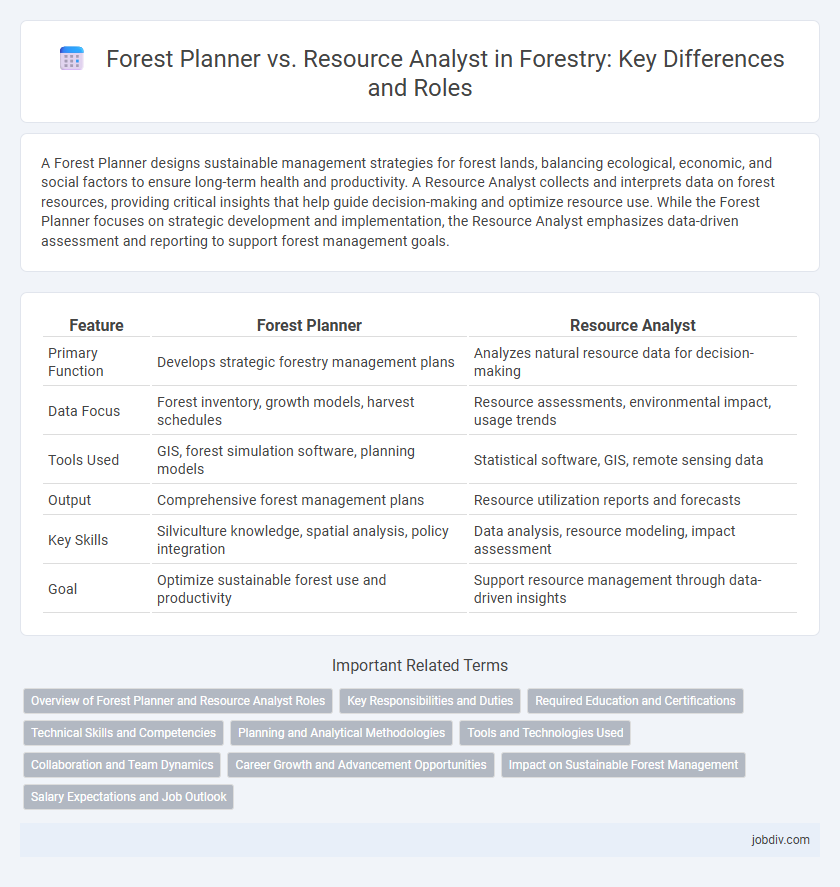A Forest Planner designs sustainable management strategies for forest lands, balancing ecological, economic, and social factors to ensure long-term health and productivity. A Resource Analyst collects and interprets data on forest resources, providing critical insights that help guide decision-making and optimize resource use. While the Forest Planner focuses on strategic development and implementation, the Resource Analyst emphasizes data-driven assessment and reporting to support forest management goals.
Table of Comparison
| Feature | Forest Planner | Resource Analyst |
|---|---|---|
| Primary Function | Develops strategic forestry management plans | Analyzes natural resource data for decision-making |
| Data Focus | Forest inventory, growth models, harvest schedules | Resource assessments, environmental impact, usage trends |
| Tools Used | GIS, forest simulation software, planning models | Statistical software, GIS, remote sensing data |
| Output | Comprehensive forest management plans | Resource utilization reports and forecasts |
| Key Skills | Silviculture knowledge, spatial analysis, policy integration | Data analysis, resource modeling, impact assessment |
| Goal | Optimize sustainable forest use and productivity | Support resource management through data-driven insights |
Overview of Forest Planner and Resource Analyst Roles
Forest Planners develop strategic management plans for forestlands, integrating ecological, economic, and social factors to promote sustainable forest use and conservation. Resource Analysts evaluate data related to forest resources, such as timber yield, wildlife habitats, and environmental impacts, to support decision-making and policy development. Both roles contribute to effective forest management but differ in focus, with planners emphasizing long-term strategy and analysts concentrating on data-driven assessments.
Key Responsibilities and Duties
A Forest Planner develops strategic management plans to ensure sustainable forest growth, focusing on timber inventory, harvesting schedules, and reforestation efforts. A Resource Analyst collects and analyzes ecological, economic, and environmental data to assess resource availability and optimize forest utilization. Both roles collaborate to balance conservation goals with commercial objectives, using GIS technology and data modeling for informed decision-making.
Required Education and Certifications
A Forest Planner typically requires a bachelor's degree in forestry, natural resource management, or environmental science, often complemented by certifications such as the Society of American Foresters (SAF) Certified Forester credential. Resource Analysts generally need a degree in environmental science, geography, or data analysis, with certifications like Geographic Information Systems Professional (GISP) or Certified Environmental Professional (CEP) enhancing their qualifications. Both roles benefit from specialized training in ecosystem management and sustainable resource utilization to optimize forest conservation and development strategies.
Technical Skills and Competencies
Forest Planners excel in Geographic Information Systems (GIS), remote sensing, and forest inventory techniques to develop sustainable management plans tailored to specific ecosystems. Resource Analysts specialize in data analysis, modeling software such as R or Python, and statistical methods to evaluate forest resource availability and environmental impacts. Both roles demand proficiency in ecological principles and strong problem-solving skills to support evidence-based forestry decisions.
Planning and Analytical Methodologies
Forest planners utilize spatial modeling and growth projection techniques to develop sustainable harvesting schedules and land-use plans. Resource analysts apply statistical analysis, remote sensing data, and GIS technologies to assess forest health, economic impacts, and resource availability. Both roles integrate predictive analytics and scenario planning to optimize forest management and conservation outcomes.
Tools and Technologies Used
Forest Planners utilize GIS software, remote sensing data, and advanced modeling tools to design sustainable forest management plans and optimize land use. Resource Analysts rely heavily on statistical analysis software, database management systems, and environmental monitoring tools to assess forest inventory data and evaluate resource conditions. Both roles integrate satellite imagery and GPS technology to enhance accuracy in forest resource assessment and decision-making processes.
Collaboration and Team Dynamics
Forest Planners and Resource Analysts collaborate closely to optimize sustainable forest management by integrating ecological data with economic and operational planning. Effective team dynamics arise from their complementary expertise, with Forest Planners focusing on spatial and temporal forest growth models while Resource Analysts assess resource availability and environmental impacts. This synergy enhances decision-making processes and supports adaptive management strategies in complex forestry projects.
Career Growth and Advancement Opportunities
Forest Planners typically experience career growth through roles in project management, land use planning, and environmental consulting, leveraging skills in GIS and ecosystem management. Resource Analysts advance by specializing in data analysis, resource inventory, and sustainability assessment, often moving into strategic planning or policy development positions. Both careers offer pathways to leadership in forestry management and environmental stewardship, with advancement opportunities influenced by expertise in technology integration and regulatory knowledge.
Impact on Sustainable Forest Management
The Forest Planner plays a critical role in designing and implementing sustainable harvesting schedules that balance ecological preservation with timber production, ensuring long-term forest health. In contrast, the Resource Analyst provides data-driven insights on forest biodiversity, soil quality, and climate impact, enabling informed decision-making for adaptive management strategies. Together, their contributions optimize sustainable forest management by integrating practical planning with comprehensive resource assessment.
Salary Expectations and Job Outlook
Forest Planners typically earn an average salary ranging from $50,000 to $75,000 annually, with strong job prospects driven by increasing demand for sustainable land management and reforestation projects. Resource Analysts, often positioned in environmental consulting or governmental roles, command salaries between $55,000 and $80,000, benefiting from growth due to expanding natural resource conservation efforts. Both professions anticipate steady employment growth, with Resource Analysts experiencing slightly higher potential due to the integration of data analytics in forestry resource management.
Forest Planner vs Resource Analyst Infographic

 jobdiv.com
jobdiv.com